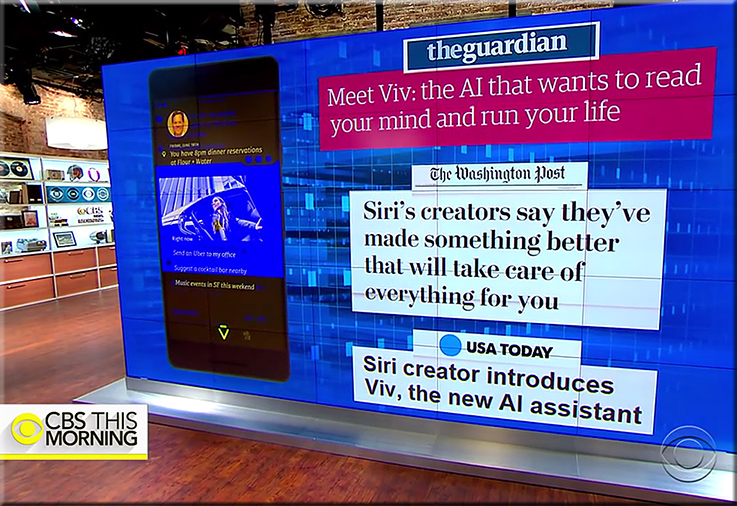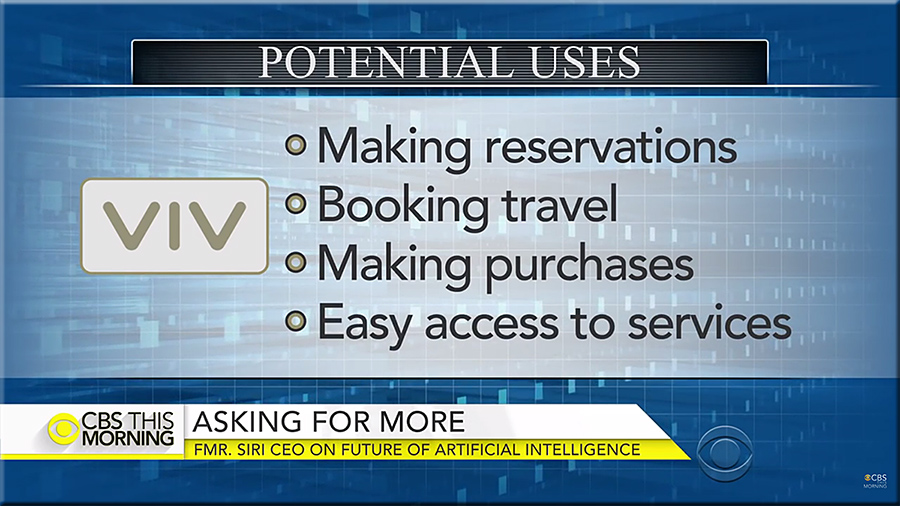From DSC:
The pace of technological development is moving extremely fast; the ethical, legal, and moral questions are trailing behind it (as is normally the case). But this exponential pace continues to bring some questions, concerns, and thoughts to my mind. For example:
- What kind of future do we want?
- Just because we can, should we?
- Who is going to be able to weigh in on the future direction of some of these developments?
- If we follow the trajectories of some of these pathways, where will these trajectories take us? For example, if many people are out of work, how are they going to purchase the products and services that the robots are building?
These and other questions arise when you look at the articles below.
This is the 8th part of a series of postings regarding this matter.
The other postings are in the Ethics section.
Robot companions are coming into our homes – so how human should they be? — from theconversation.com
Excerpt:
What would your ideal robot be like? One that can change nappies and tell bedtime stories to your child? Perhaps you’d prefer a butler that can polish silver and mix the perfect cocktail? Or maybe you’d prefer a companion that just happened to be a robot? Certainly, some see robots as a hypothetical future replacement for human carers. But a question roboticists are asking is: how human should these future robot companions be?
A companion robot is one that is capable of providing useful assistance in a socially acceptable manner. This means that a robot companion’s first goal is to assist humans. Robot companions are mainly developed to help people with special needs such as older people, autistic children or the disabled. They usually aim to help in a specific environment: a house, a care home or a hospital.
The Next President Will Decide the Fate of Killer Robots—and the Future of War – from wired.com by Heather Roff and P.W. Singer
Excerpt:
The next president will have a range of issues on their plate, from how to deal with growing tensions with China and Russia, to an ongoing war against ISIS. But perhaps the most important decision they will make for overall human history is what to do about autonomous weapons systems (AWS), aka “killer robots.” The new president will literally have no choice. It is not just that the technology is rapidly advancing, but because of a ticking time bomb buried in US policy on the issue.
Your new manager will be an algorithm — from stevebrownfuturist.com
Excerpt:
It sounds like a line from a science fiction novel, but many of us are already managed by algorithms, at least for part of our days. In the future, most of us will be managed by algorithms and the vast majority of us will collaborate daily with intelligent technologies including robots, autonomous machines and algorithms.
Algorithms for task management
Many workers at UPS are already managed by algorithms. It is an algorithm that tells the humans the optimal way to pack the back of the delivery truck with packages. The algorithm essentially plays a game of “temporal Tetris” with the parcels and packs them to optimize for space and for the planned delivery route–packages that are delivered first are towards the front, packages for the end of the route are placed at the back.
Beware of biases in machine learning: One CTO explains why it happens — from enterprisersproject.com by Minda Zetlin
Excerpt:
The Enterprisers Project (TEP): Machines are genderless, have no race, and are in and of themselves free of bias. How does bias creep in?
Sharp: To understand how bias creeps in you first need to understand the difference between programming in the traditional sense and machine learning. With programming in the traditional sense, a programmer analyses a problem and comes up with an algorithm to solve it (basically an explicit sequence of rules and steps). The algorithm is then coded up, and the computer executes the programmer’s defined rules accordingly.
With machine learning, it’s a bit different. Programmers don’t solve a problem directly by analyzing it and coming up with their rules. Instead, they just give the computer access to an extensive real-world dataset related to the problem they want to solve. The computer then figures out how best to solve the problem by itself.
Technology vs. Humanity – The coming clash between man and machine — from futuristgerd.com by Gerd Leonhard
Excerpt (emphasis DSC):
In his latest book ‘Technology vs. Humanity’, futurist Gerd Leonhard once again breaks new ground by bringing together mankind’s urge to upgrade and automate everything (including human biology itself) with our timeless quest for freedom and happiness.
Before it’s too late, we must stop and ask the big questions: How do we embrace technology without becoming it? When it happens—gradually, then suddenly—the machine era will create the greatest watershed in human life on Earth.
Digital transformation has migrated from the mainframe to the desktop to the laptop to the smartphone, wearables and brain-computer interfaces. Before it moves to the implant and the ingestible insert, Gerd Leonhard makes a last-minute clarion call for an honest debate and a more philosophical exchange.
Ethics: Taming our technologies
The Ethics of Invention: Technology and the Human Future — from nature.com by Sheila Jasanoff
Excerpt:
Technological innovation in fields from genetic engineering to cyberwarfare is accelerating at a breakneck pace, but ethical deliberation over its implications has lagged behind. Thus argues Sheila Jasanoff — who works at the nexus of science, law and policy — in The Ethics of Invention, her fresh investigation. Not only are our deliberative institutions inadequate to the task of oversight, she contends, but we fail to recognize the full ethical dimensions of technology policy. She prescribes a fundamental reboot.
Ethics in innovation has been given short shrift, Jasanoff says, owing in part to technological determinism, a semi-conscious belief that innovation is intrinsically good and that the frontiers of technology should be pushed as far as possible. This view has been bolstered by the fact that many technological advances have yielded financial profit in the short term, even if, like the ozone-depleting chlorofluorocarbons once used as refrigerants, they have proved problematic or ruinous in the longer term.
Robotics is coming faster than you think — from forbes.com by Kevin O’Marah
Excerpt:
This week, The Wall Street Journal featured a well-researched article on China’s push to shift its factory culture away from labor and toward robots. Reasons include a rise in labor costs, the flattening and impending decrease in worker population and falling costs of advanced robotics technology.
Left unsaid was whether this is part of a wider acceleration in the digital takeover of work worldwide. It is.
Adidas will open an automated, robot-staffed factory next year — from businessinsider.com
Beyond Siri, the next-generation AI assistants are smarter specialists — from fastcompany.com by Jared Newman
SRI wants to produce chatbots with deep knowledge of specific topics like banking and auto repair.
Machine learning
Of prediction and policy — from economist.com
Governments have much to gain from applying algorithms to public policy, but controversies loom
Excerpt:
FOR frazzled teachers struggling to decide what to watch on an evening off (DC insert: a rare event indeed), help is at hand. An online streaming service’s software predicts what they might enjoy, based on the past choices of similar people. When those same teachers try to work out which children are most at risk of dropping out of school, they get no such aid. But, as Sendhil Mullainathan of Harvard University notes, these types of problem are alike. They require predictions based, implicitly or explicitly, on lots of data. Many areas of policy, he suggests, could do with a dose of machine learning.
Machine-learning systems excel at prediction. A common approach is to train a system by showing it a vast quantity of data on, say, students and their achievements. The software chews through the examples and learns which characteristics are most helpful in predicting whether a student will drop out. Once trained, it can study a different group and accurately pick those at risk. By helping to allocate scarce public funds more accurately, machine learning could save governments significant sums. According to Stephen Goldsmith, a professor at Harvard and a former mayor of Indianapolis, it could also transform almost every sector of public policy.
…
But the case for code is not always clear-cut. Many American judges are given “risk assessments”, generated by software, which predict the likelihood of a person committing another crime. These are used in bail, parole and (most controversially) sentencing decisions. But this year ProPublica, an investigative-journalism group, concluded that in Broward County, Florida, an algorithm wrongly labelled black people as future criminals nearly twice as often as whites. (Northpointe, the algorithm provider, disputes the finding.)
‘Software is eating the world’: How robots, drones and artificial intelligence will change everything — from business.financialpost.com
Thermostats can now get infected with ransomware, because 2016 — from thenextweb.com by Matthew Hughes
Who will own the robots? — from technologyreview.com by David Rotman
We’re in the midst of a jobs crisis, and rapid advances in AI and other technologies may be one culprit. How can we get better at sharing the wealth that technology creates
Police Drones Multiply Across the Globe — from dronelife.com by Jason Reagan
LinkedIn lawsuit may signal a losing battle against ‘botnets’, say experts — from bizjournals.com by Annie Gaus
China’s Factories Count on Robots as Workforce Shrinks — from wsj.com by Robbie Whelan and Esther Fung
Rising wages, cultural changes push automation drive; demand for 150,000 robots projected for 2018
Researchers Are Growing Living Biohybrid Robots That Move Like Animals — from slate.com by Victoria Webster
Addendums on 9/14/16:
- The rise of robots: forget evil AI – the real risk is far more insidious — from theguardian.com
It’s far more likely that robots would inadvertently harm or frustrate humans while carrying out our orders than they would rise up against us - Governments and nation states are now officially training for cyberwarfare: An inside look — from techrepublic.com by Steve Ranger











